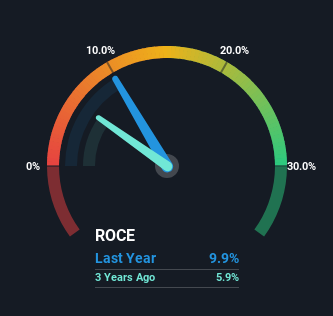What financial metrics can indicate to us that a company is maturing or even in decline? Typically, we’ll see the trend of both return on capital employed (ROCE) declining and this usually coincides with a decreasing amount of capital employed. This combination can tell you that not only is the company investing less, it’s earning less on what it does invest. Having said that, after a brief look, Linamar (TSE:LNR) we aren’t filled with optimism, but let’s investigate further.
What Is Return On Capital Employed (ROCE)?
For those that aren’t sure what ROCE is, it measures the amount of pre-tax profits a company can generate from the capital employed in its business. Analysts use this formula to calculate it for Linamar:
Return on Capital Employed = Earnings Before Interest and Tax (EBIT) ÷ (Total Assets – Current Liabilities)
0.099 = CA$711m ÷ (CA$9.6b – CA$2.4b) (Based on the trailing twelve months to June 2023).
Therefore, Linamar has an ROCE of 9.9%. Even though it’s in line with the industry average of 9.9%, it’s still a low return by itself.
View our latest analysis for Linamar
Above you can see how the current ROCE for Linamar compares to its prior returns on capital, but there’s only so much you can tell from the past. If you’re interested, you can view the analysts predictions in our free report on analyst forecasts for the company.
How Are Returns Trending?
We are a bit worried about the trend of returns on capital at Linamar. To be more specific, the ROCE was 12% five years ago, but since then it has dropped noticeably. On top of that, it’s worth noting that the amount of capital employed within the business has remained relatively steady. Companies that exhibit these attributes tend to not be shrinking, but they can be mature and facing pressure on their margins from competition. So because these trends aren’t typically conducive to creating a multi-bagger, we wouldn’t hold our breath on Linamar becoming one if things continue as they have.
The Bottom Line
In the end, the trend of lower returns on the same amount of capital isn’t typically an indication that we’re looking at a growth stock. In spite of that, the stock has delivered a 13% return to shareholders who held over the last five years. Regardless, we don’t like the trends as they are and if they persist, we think you might find better investments elsewhere.
Like most companies, Linamar does come with some risks, and we’ve found 1 warning sign that you should be aware of.
While Linamar isn’t earning the highest return, check out this free list of companies that are earning high returns on equity with solid balance sheets.
Have feedback on this article? Concerned about the content? Get in touch with us directly. Alternatively, email editorial-team (at) simplywallst.com.
This article by Simply Wall St is general in nature. We provide commentary based on historical data and analyst forecasts only using an unbiased methodology and our articles are not intended to be financial advice. It does not constitute a recommendation to buy or sell any stock, and does not take account of your objectives, or your financial situation. We aim to bring you long-term focused analysis driven by fundamental data. Note that our analysis may not factor in the latest price-sensitive company announcements or qualitative material. Simply Wall St has no position in any stocks mentioned.
